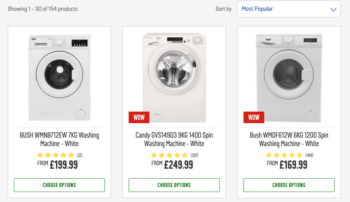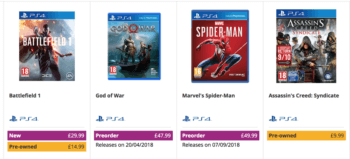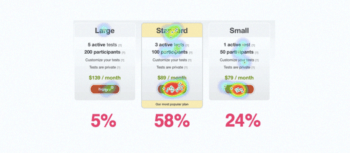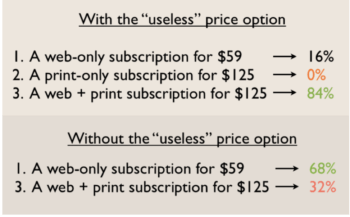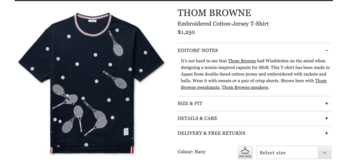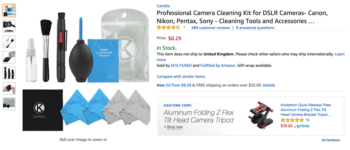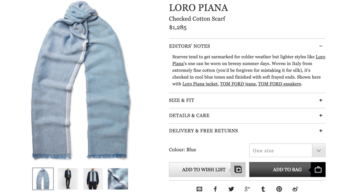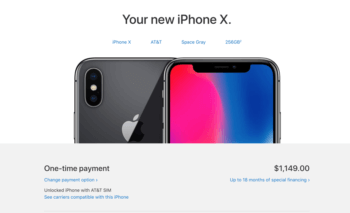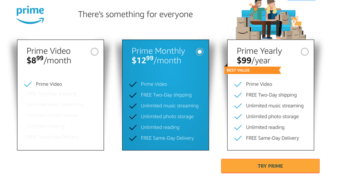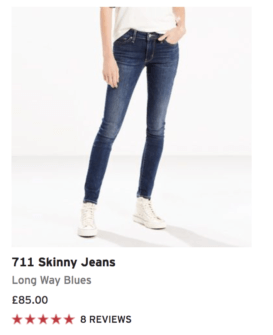Latest news about Bitcoin and all cryptocurrencies. Your daily crypto news habit.
 This post originally appeared on the Optimizely Blog.Optimizely, Hacker Noon’s weekly sponsor, is the world’s leader in digital experience optimization, allowing businesses to dramatically drive up the value of their digital products, commerce, and campaigns through its best in class experimentation software platform. Optimizely enables product development teams to accelerate innovation, lower the risk of new features, and drive up the return on investment from digital by up to 10X.
This post originally appeared on the Optimizely Blog.Optimizely, Hacker Noon’s weekly sponsor, is the world’s leader in digital experience optimization, allowing businesses to dramatically drive up the value of their digital products, commerce, and campaigns through its best in class experimentation software platform. Optimizely enables product development teams to accelerate innovation, lower the risk of new features, and drive up the return on investment from digital by up to 10X.
Pricing and finding the most appropriate online pricing strategy are important to everyone, especially in the world of e-commerce. Price influences the consumer’s likelihood to purchase. Price your items too low and you run the risk of losing significant profit. Price your items too high and you run the risk of alienating your customers.
You may have a winning product, but it means nothing if you can’t convince someone to buy it.
But it doesn’t have to be that way.
There are a number of different psychological pricing strategies you can implement to encourage people to make a purchase.
In this article, we’re going to look at 9 different pricing strategies that influence or persuade people to buy.
And when you start implementing these strategies, you will increase both conversions and profits.
What is psychological pricing?
E-commerce psychological pricing is an approach that uses prices to influence people when making a decision about buying. It helps you price your products at that sweet-spot that encourages them to buy. It helps you pander to consumer’s automatic beliefs when they see the price of something.
The practice has been around for some time in brick and mortar stores, however, it’s highly applicable to e-commerce stores too.
For many e-commerce store owners, implementing psychological pricing is the money-maker that will see increased profits across their entire business.
Power of 9
How much do you know about the number 9? Well, when it comes to pricing, it’s a super important number.
If you haven’t considered using the number 9 in your pricing before, this section will hopefully help you understand why it’s a valuable approach.
In e-commerce, the number ‘9’ is often associated with discounts and promotions.
$3.99 seems way cheaper than $4.00, even though the difference is only $0.01
This approach is sometimes referred to as the “left-digit effect” where consumers focus on the first number and instead round down rather than up.
So in our above example,
$3.99 seems closer to $3.00 than $4.00.
The power of 9 strategies, or left digit effect is most common when selling product appealing to people looking for a discount.
In this example, UK retailer, Argos, use the power of nine to sell washing machines.
Here 199.99 feels closer to £100 than it does to £200.
It doesn’t just have to be a technique for high-ticket items though. Game retailers often use it to increase the number of games a customer will buy at any one point.
Comparison pricing
Sometimes, psychological pricing is actually not about changing the prices of your products, but instead about how you position the value of a product compared to something else.
This is often seen in brick-and-mortar stores where they put two similar product together, let’s say a hairdryer for £15 and a hairdryer for £175.
The same approach can be true of e-commerce stores too. Whether you like it or not, a majority of your customers will be comparing the prices of items before they hit buy. Sometimes on your competitor’s websites and sometimes just on your own website.
If you’re trying to sell a product, position premium options next to “normal” priced products to see if the cheaper one sells more.
Think about it like this:
In this example, the standard package sold best when compared with the other two options. By forcing buyers to compare offers, you allow them to create an ideal image of the services they want and the price they’re happy to pay for it.
Here we’ve taken the first price as the anchor to which we’ll compare everything else to.
In this scenario, customers feel as though they’re getting a good deal because of the value. The premium option seems too out-of-this-world for them to buy, the standard items seem like a bargain in comparison.
Useless price points
Useless price points is a psychological strategy that pushes a consumer towards a certain product or package based on comparisons.
This works especially well for packaged prices.
If you have:
- Item A for $100
- Item B for $200
- Item A & B for $200
You might be wondering: ‘Hey? It’s the same price for A&B as it is for just B. This is true and it’s because they’ve implemented a useless price point.
It’s a useless price point because item B is useless, you might as well get A and B for the exact same price.
It all leads back to what we’ve been discussing so far, psychological pricing works best when you can change the perceived value of something.
Context pricing
Is $2000 a lot of money?
Perhaps to some people yes, but to others no. When it comes to pricing your items, you need to think about context.
If I told you, I was going to sell you my Lamborghini for $1250, would you consider this as cheap or expensive? Probably cheap when you consider how much it’s actually worth.
If I told you I was going to sell you my t-shirt for $1250, would you consider this as cheap or expensive? Probably very expensive.
This is why context matters so much in pricing.
Where you buy matters just as much as what you buy.
You’d expect a t-shirt from the thrift store to be cheaper than a t-shirt from a designer outlet because you understand the context of the two stores.
Bundle pricing
When you buy a camera, would you also buy the cleaning kit bundle for an additional cost?
Probably. You’ve just bought the camera, you want to keep it in a good condition. That’s why product bundles are a great way to increase sales.
They work in two ways because the customer either thinks:
- It works out cheaper to buy this bundle altogether
- It’s easier to buy it altogether rather than individually
Bundling products together reduces the friction of making a purchase. $50 for 10 items seems like a great, easy purchase to make as opposed to
- Item one: $2.00
- Item two: $3.00
- Item three: $4.56
- Item four: $5.44
- Item five: $9.50
- Item six: $0.50
- Item seven: $15.50
- Item eight: $4.50
- Item nine: $2.50
- Item ten: $2.50
It works this way because even though we like buying things, we don’t actually like buying things. And so buying all those ten items individually seems like much more of an overwhelming commitment to spending the exact same amount on a bundled package.
More money = more value
How many times have you seen a piece of clothing on a designer website? Perhaps say this scarf for $1285:
Some of you will say “that’s absurd, how they can justify charging that price for that item?”
Others, however, will say “that’s expensive, but it’s understandable, after all, it is this brand”.
When it comes to pricing, sometimes pricing high is the way to go, if you can also ensure you’re offering an element of unique value too. This is usually done through the brands messaging.
It’s because people associate premium prices with premium products. Let’s look at Apple’s aggressive pricing as an example.
They never set out to make a budget phone, and their prices reflect that. When you think about it, spending over $1000 on a phone seems ludicrous, but many, many people buy them every single year.
They don’t offer discounts, other than student discounts, but even then, spending $1000+ on a laptop for a cash strapped student is still a silly idea — yet they do it every year.
They’ve made no secret about their pricing model, they price high and that’s because of the brand image they’ve created. A recent study showed it costs apple $247.51 to create an iphone, that’s a profit margin of $452 before other overhead costs.
After all, you get what you pay for, right?
It’s why when presented with two options with two different prices people often go for the more expensive one because they think “well it must be expensive for a reason,”
Fragmented pricing
Would you rather pay $42 a month or $500 up front for a year? They work out to be the same price give or take a dollar or two, yet there is a significant change in perception when you compare the two.
$500 upfront feels like a much bigger investment. It carries more risk. What if you pay the $500 and stop using the product or service three months in?
That’s why it’s a good idea if you have a product that can be split into installements to offer a fragmented pricing strategy.
Fragmented pricing works best for subscription-based eCommerce like Amazon Prime.
Urgency
No one like to miss out, therefore consumers are much more likely to buy a time-sensitive product. Think about in brick and mortar stores, how many times have you seen “hurry, whilst stocks last” “closing down sale, everything must go”, you can sway an undecided buyer online, just as you can in brick-and-mortar stores.
Seeing things like this compels you to take action.
This isn’t the only way to create a sense of urgency though, you could have “running low-only two products left”.
In the above example, Pet Pro Supply uses urgency in their flash sale with a time sensitive deal and free shipping.
The fact that a product might no longer be available to buy again also adds a sense or urgency as customer aim to get a piece of the pie.
Use social proof to sell more
Social proof is a psychological phenomenon that occurs when someone assumes the actions of others reflect correct behavior for a given situation. In other words, we do what other people do because, err, other people are doing it.
How often have you thought about buying something on amazon only to see that it’s never had a review before?
Even if the product looks great, how do you know it’s a good product if there’s no one else to attest that their experience with this particular seller was good.
And even more so, if there is the same product from another seller with 10000 positive reviews, despite being more expensive, you’re likely to go for that one instead, even if it was more expensive.
This is because of social proof. Social proof is an effective pricing strategy that encourages buyers to look to at the experience of others before they make a purchase.
It’s an effective strategy because it means you can sell more because you’ve already built up that trust with buyers. You can show this more accurately by putting the reviews really close to the pricing as Levi Jeans does in the example below.
They see a huge price tag, but then they also see 8 five star reviews.
Takeaways
Psychological pricing strategies can have a big influence on the ay people but from you. By taking into account your buyer’s psychological tendencies and using different pricing tactics such as comparison pricing, contextual pricing, and bundling, you can potentially dramatically improve your conversions.
What psychological pricing strategies will you test out?
This post originally appeared on the Optimizely Blog.Optimizely, Hacker Noon’s weekly sponsor, is the world’s leader in digital experience optimization, allowing businesses to dramatically drive up the value of their digital products, commerce, and campaigns through its best in class experimentation software platform. Optimizely enables product development teams to accelerate innovation, lower the risk of new features, and drive up the return on investment from digital by up to 10X.
9 Pricing Psychology Jedi Mind Tricks was originally published in Hacker Noon on Medium, where people are continuing the conversation by highlighting and responding to this story.
Disclaimer
The views and opinions expressed in this article are solely those of the authors and do not reflect the views of Bitcoin Insider. Every investment and trading move involves risk - this is especially true for cryptocurrencies given their volatility. We strongly advise our readers to conduct their own research when making a decision.
